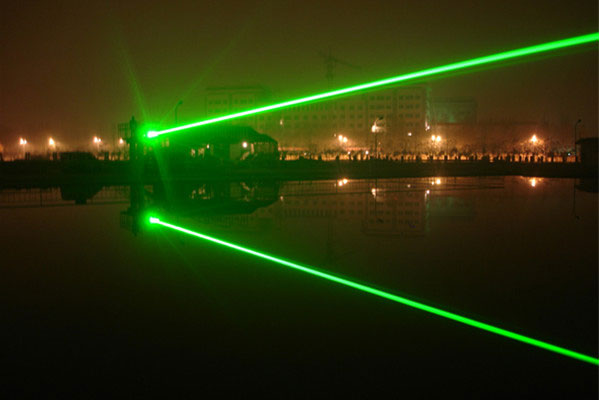How does the carbon dioxide laser transition?Posted by Mike on February 25th, 2017 Carbon dioxide laser by C.Kumar N.Patel in 1964 in Bell Labs invention, is the photonics industry standard ancient technology. But despite its long history, CO2 laser technology continues to flourish with its unique wavelength, power and spectral purity, and continues to be used. Because many natural and synthetic materials have strong characteristic absorption over the 9-12 μm spectral range across CO2 high power laser pointer, there are many opportunities in material handling and spectral analysis. These wavelengths are also included in the important window of atmospheric transmission and are ideal for many sensing and ranging applications. A typical CO2 laser consists of a large amount of gas discharge from a mixed CO2 molecule. Due to the very close to the energy level of molecular vibrations and rotations, the photons emitted between these energy levels have low energy and long wavelengths compared to visible and near infrared (NIR) light. Carbon dioxide lasers offer power levels from milliwatts to tens of kilowatts, ranging from small instruments to high power cutting. And because the CO2 laser has a very high spectral purity, with <1kHz radiation width and no power trade-off, conversion efficiency of up to 10%. These features enable CO2 burning laser pointer to address emerging applications such as material processing, photodetection and ranging (lidar), thermal visual aids, and targeted therapeutic medical applications. In industrial applications, high-power fiber lasers offer higher efficiency and better metal absorption at lower cost. However, CO2 lasers are still the only choice for non-metallic materials that handle many NIR wavelengths that do not absorb fiber lasers. The quantum cascade laser is small in size and wavelengths can span 2-12μm, making it ideal for spectroscopy. However, in the long-wave infrared (LWIR) band of 8-12μm, many sensing and spectrally sensitive industrial and medical applications require high power, spectral purity, excellent coherence and stable spatial pattern combined with this requirement only CO2 The laser can be provided. While CO2 lasers can solve all the industrial needs of the era is coming to an end, we are facing new materials and increasingly demanding industrial processes brought about by the challenges that require a deeper understanding of the true value proposition of the 10mw laser pointer, as well as the manufacture and sale of carbon dioxide lasers The different methods. In terms of manufacturing, this new paradigm closely matches the specific customer requirements using CO2 laser wide range specifications. In terms of marketing, from the original way of the average power pricing to customer-specific program pricing, such as pulse shaping, peak power, wavelength characteristics and operational stability to match the special materials and application requirements. On the road to the expansion of Moore's Law, carbon dioxide lasers have been identified as the best tools for laser generation of plasma to produce extreme ultraviolet radiation. This 13.5 nm EUV light is produced by evaporating the molten droplets of tin. While testing other lasers for such applications, such as Nd: YAG lasers, the efficiency is not high for carbon dioxide lasers, because tin has a much higher reflectivity for CO2 laser lighting, so carbon dioxide 5mw green laser produce higher speed and better plasma properties Optical flow The carbon dioxide laser is a reasonable way to adjust the optical device because its output beam is highly absorbed by the LIGO optics and it can provide high wavelength purity and power stability without increasing the noise to the measurement. However, according to LIGO specific specific application requirements, the development of single-wavelength stable CO2 laser, suitable for real-time adaptive system is very precise control loop, accurate offset optical distortion. When the optical element is insufficiently compensated for thermal deformation, the CO2 violet laser pointer beam is shaped as a ring to provide additional compensation (overtemperature correction), and if the optical element is over-compensated, the CO2 laser beam is shaped as a disk in the center of the optical element Compensation (under thermal correction). The new multilayer plastic has a very strong absorption peak at a particular line in the CO2 spectrum, and even requires a laser to rapidly convert wavelengths from one layer to another during the cutting process. The replacement of a large knife-and-die system would require a laser array to produce almost no heat-affected area excision while tracking hundreds of feet per second of mobile web. This dedicated 1mw laser pointer requires a high accuracy at a single wavelength in the spectrum, with a potential high peak power of 100 to 1 or even higher for the average power ratio and a fast (> 10 kHz) pulse. Traditionally, such peak power and fast pulses require Q-switches or other external modulation techniques that are too expensive for large-scale deployment of such industries. However, we are developing kilowatts of peak power for carbon dioxide, with no small form factor external modulation to meet these requirements. In fact, the latest trends in manufacturing, medicine, and materials science are forcing the value proposition of "dollar / watt" over the past half century to evolve into a customer-centric, customized era of CO2 lasers. https://www.fluther.com/199056/remote-laser-processing-technology/ Like it? Share it!More by this author |



